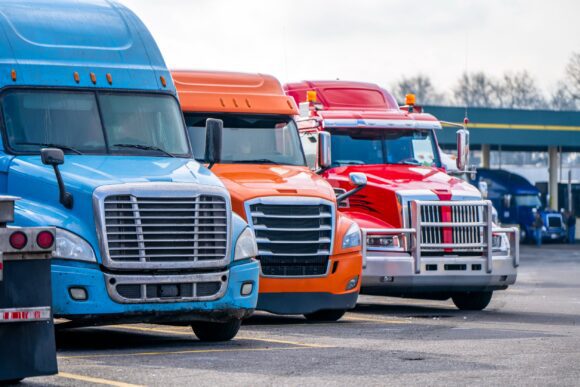Practices to Minimize Your Fleet’s Insurance Costs

This post is part of a series sponsored by IAT Insurance Group.
Equipment, diesel, tires, insurance premiums and inflation weigh heavy on trucking companies, big and small.
Over the last decade, transportation insurance premiums have increased 47% per mile.[1] And with diesel prices increasing over 46% in two years, fleet owners are left to strategize how to minimize the cost of doing business.[2]
Inflationary pressures on truck parts driven by supply chain issues as well as the rise of nuclear verdicts has been a major cause of rising insurance premiums in the last few years. A recent $1 billion dollar verdict by a Florida jury found two trucking companies negligent, making this case one of the highest awards to a plaintiff to date. Even smaller verdicts make a significant impact on trucking companies. For example, a recent study found settlement payments are 37.7% higher than verdict awards and 393% more likely to be paid out if a fatality has occurred.[3]
Below are five best practices fleet owners can implement to minimize their insurance costs.
1. Compliance, Safety, Accountability (CSA) scores
One of the first criteria an underwriter looks at to determine coverage pricing is an applicant’s CSA Behavior Analysis and Safety Improvement Categories (BASIC) Score. The Federal Motor Carrier Safety Administration (FMCSA) updates scores once a month and organizes the information into seven categories, generated using data from two years of roadside inspections, crash reports and investigations to identify and intervene with motor carriers that pose the greatest risk to safety. Elevated CSA scores could reduce your customer base, increase inspections while on the road, warrant a DOT review or result in drivers going to other carriers with better CSA scores.
INDUSTRY TIP: Monitor your scores at least monthly. The entire team should be aware of the scores and know how their effort can have an impact on the scores and the overall company.
2. Recruiting and onboarding of drivers
The majority of accidents result from poor driver decisions or behaviors. Insurance underwriters carefully evaluate how a risk selects and manages its driver pool. Conversations surrounding the cost of recruiting a driver range from $5k-$10k. [4] Improving your retention rates by just one, two or even three drivers could save fleet owners $5k – $30k. While onboarding drivers, it is important to adhere to DOT regulations and industry best practices. Going above and beyond the basics like using DOT’s Pre-Employment Screening Program (PSP) and administering a road test can help fleet owners make better hiring/leasing decisions.
Driver reviews at 30, 60 and 90 days can help review company policies and celebrate a good driving record, in addition to gathering feedback and managing expectations from both the employee’s perspective and the employers.
INDUSTRY TIP: The orientation of new drivers is the first opportunity to showcase your safety culture. Although not required by DOT regulations, a documented road test is a best practice. That, along with a PSP are just a couple of efforts a carrier can complete to go above and beyond DOT regulations.
3. Driver turnover
Companies with high driver turnover rates statistically have higher CSA scores and higher accident frequency. Vigillo, now Samba Safety, reported that trucking companies with high turnover rates “had a driver out-of-service rate 189 percent higher” than low-turnover trucking companies. The vehicle OOS volume for those high-turnover carriers was “300 percent higher.”[5] Risks with lower turnover rates will be more appealing to an underwriter.
It can be argued that culture can be measured in turnover rates. Drivers that feel taken care of will stay and be good performers. Understand the competition and know who they are, what they do, their pay scale, benefits package, traffic lanes and CSA scores.
INDUSTRY TIP: Be transparent during the recruiting process and diligent in gathering information during exit interviews. Better recruiting efforts and understanding drivers needs/wants can help to reduce turnover.
4. Cost of accidents
There are both direct and indirect costs after collisions. Direct costs can include equipment and cargo repair, loss of revenue, administrative costs and insurance premiums. Indirect costs can include the loss of a customer, equipment down time and the loss of the driver.
INDUSTRY TIP: Look for different ways to increase safety among drivers. This could be in the form of formal safety meetings, one-on-one communication with the drivers, online safety training, reviewing telematics data with the driver, guest speakers and educating drivers on the accident trends observed by the company and the industry.
5. Leverage technology in vehicles
Technology can help monitor the performance of equipment and drivers. Performance measures such as speed, proximity to others, RPM, idle times and other valuable information are available via telematics. Devices such as cameras are also available. Using these tools in a proactive manner can help to optimize equipment performance and used to provide feedback to the drivers as needed. This data can be used to improve fuel consumption and have an impact on the bottom line to minimize expenses, reduce accidents and improve retention.
INDUSTRY TIP: During onboarding, make sure drivers understand the functionality of how the camera works, when it records and how the system operates. Knowing what triggers events can help to reduce distractive driving.
Contact IAT to discover how your fleet can be in the best position for insurance costs.
By Nick Martin
[1] American Transportation Research Institute “The Impacts of Rising Insurance Costs on the Trucking Industry,” February 2022.
[2] American Transportation Research Institute “The Impacts of Rising Insurance Costs on the Trucking Industry,” February 2022.
[3] ATRI “New ATRI Study Quantifies the Impact of Smaller Verdicts and Settlements on the Trucking Industry,” November 2021.
[4] Upper Great Plains Transportation Institute “The Cost of Truckload Driver Turnover,” 2001.
[5] Avatar Fleet “How the Trucking Industry’s Turnover Rate Impacts Safety.”
The most important insurance news,in your inbox every business day.
Get the insurance industry’s trusted newsletter





